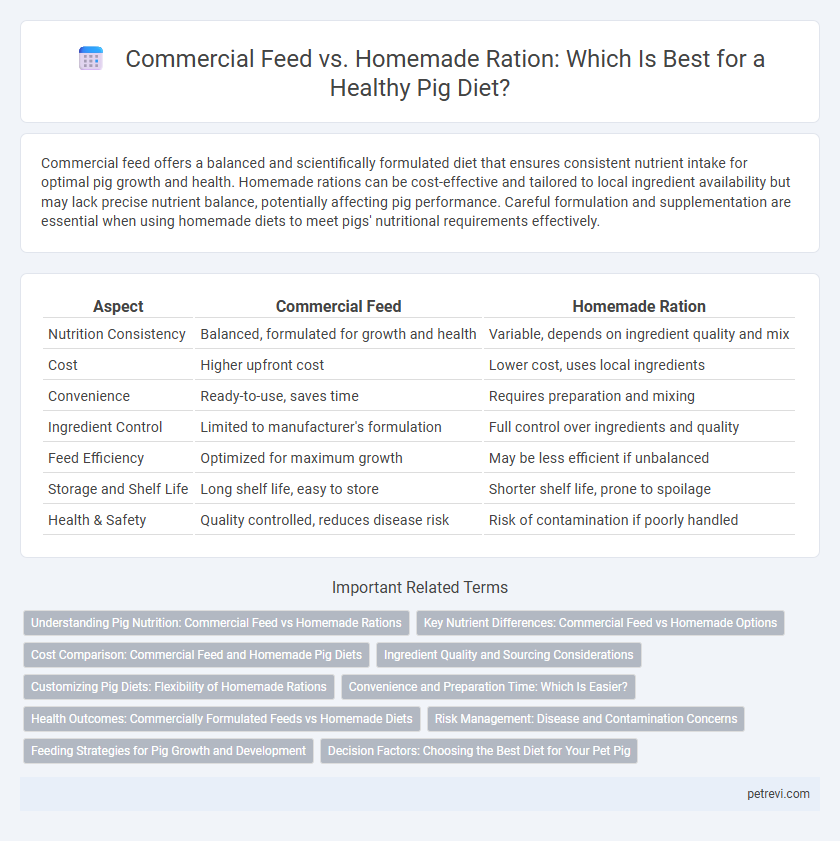Commercial feed offers a balanced and scientifically formulated diet that ensures consistent nutrient intake for optimal pig growth and health. Homemade rations can be cost-effective and tailored to local ingredient availability but may lack precise nutrient balance, potentially affecting pig performance. Careful formulation and supplementation are essential when using homemade diets to meet pigs' nutritional requirements effectively.
Table of Comparison
| Aspect | Commercial Feed | Homemade Ration |
|---|---|---|
| Nutrition Consistency | Balanced, formulated for growth and health | Variable, depends on ingredient quality and mix |
| Cost | Higher upfront cost | Lower cost, uses local ingredients |
| Convenience | Ready-to-use, saves time | Requires preparation and mixing |
| Ingredient Control | Limited to manufacturer's formulation | Full control over ingredients and quality |
| Feed Efficiency | Optimized for maximum growth | May be less efficient if unbalanced |
| Storage and Shelf Life | Long shelf life, easy to store | Shorter shelf life, prone to spoilage |
| Health & Safety | Quality controlled, reduces disease risk | Risk of contamination if poorly handled |
Understanding Pig Nutrition: Commercial Feed vs Homemade Rations
Commercial pig feeds offer a precisely formulated balance of essential nutrients, vitamins, and minerals tailored for optimal growth, reproduction, and health, ensuring consistent feed efficiency and weight gain. Homemade rations, while customizable using ingredients like corn, soybean meal, and kitchen scraps, often lack the precise nutrient balance and may lead to deficiencies or imbalances affecting pig performance. Understanding the nutrient requirements--protein levels, energy sources, fiber content, and micronutrients--is critical to choosing between commercial feed and homemade rations for sustainable pig nutrition management.
Key Nutrient Differences: Commercial Feed vs Homemade Options
Commercial pig feed is formulated to provide a balanced mix of essential nutrients such as proteins, carbohydrates, fats, vitamins, and minerals, ensuring consistent growth and health. Homemade rations often lack precise nutrient composition, leading to potential deficiencies or imbalances in amino acids, energy levels, or trace minerals critical for optimal pig performance. Key differences include the inclusion of additives like enzymes and probiotics in commercial feeds, which enhance digestion and nutrient absorption, whereas homemade diets may require careful supplementation to meet the same nutritional standards.
Cost Comparison: Commercial Feed and Homemade Pig Diets
Commercial feed for pigs often incurs higher upfront costs due to processing, packaging, and standardized nutrient content, whereas homemade rations leverage locally sourced ingredients reducing feed expenses significantly. Cost efficiency in homemade diets depends on ingredient availability and formulation accuracy, impacting growth performance and feed conversion rates. Economic viability is best evaluated by analyzing feed cost per unit of weight gain, balancing cost savings with optimal nutritional adequacy in pig diets.
Ingredient Quality and Sourcing Considerations
Commercial pig feed offers consistent ingredient quality with rigorously tested grains, vitamins, and minerals sourced from certified suppliers, ensuring balanced nutrition and minimal contamination risk. Homemade rations rely on local, often variable-quality ingredients, which can lead to nutritional imbalances if sourcing is not carefully managed and ingredient quality is inconsistent. Prioritizing ingredient quality and reliable sourcing in pig diets affects growth performance, health status, and overall feed efficiency.
Customizing Pig Diets: Flexibility of Homemade Rations
Homemade rations offer the flexibility to tailor pig diets specifically to the animal's nutritional needs, incorporating locally available ingredients such as corn, soybean meal, and farm by-products. This customization supports optimal growth performance, feed efficiency, and cost control compared to commercial feed, which comes as a fixed formulation. Farmers can adjust protein, energy, and mineral levels seasonally or based on pig weight and health status to maximize production outcomes.
Convenience and Preparation Time: Which Is Easier?
Commercial feed offers significant convenience for pig diets due to its ready-to-use formulation, reducing preparation time to mere minutes and ensuring nutrient consistency. Homemade rations require extensive ingredient measuring, mixing, and balancing, which can be time-consuming and prone to nutritional imbalances. For producers prioritizing ease and efficiency, commercial feed presents a more practical solution.
Health Outcomes: Commercially Formulated Feeds vs Homemade Diets
Commercially formulated pig feeds provide precise nutrient balance, vitamins, and minerals essential for optimal growth, enhancing immune function and reducing disease incidence compared to homemade rations. Homemade diets often lack consistent nutrient composition, leading to deficiencies or imbalances that can impair gut health and increase susceptibility to infections. Research indicates pigs on commercial feeds exhibit better weight gain, lower mortality rates, and improved overall health outcomes, emphasizing the importance of standardized nutrition in swine production.
Risk Management: Disease and Contamination Concerns
Commercial feed for pigs undergoes rigorous quality control and biosecurity measures, significantly reducing the risk of disease transmission and contamination compared to homemade rations. Homemade rations often lack standardized formulation and may introduce pathogens or toxins through untested ingredients, increasing health risks. Implementing strict hygiene protocols and sourcing certified feeds are critical strategies for effective risk management in pig diets.
Feeding Strategies for Pig Growth and Development
Commercial feed offers a precisely formulated balance of essential nutrients designed to optimize pig growth rate, feed conversion ratio, and overall health, ensuring consistent delivery of protein, vitamins, and minerals tailored to different growth stages. Homemade rations provide flexibility in ingredient selection and cost control but require careful nutrient analysis to avoid deficiencies or imbalances that can impair development and productivity. Effective feeding strategies integrate the benefits of commercial feed's nutrient precision with the adaptability of homemade rations to enhance growth performance and promote efficient nutrient utilization in pig diets.
Decision Factors: Choosing the Best Diet for Your Pet Pig
Choosing between commercial feed and homemade rations for a pig diet depends on factors such as nutrient balance, cost-effectiveness, and convenience. Commercial feeds offer scientifically formulated nutrients ensuring growth and health, while homemade rations allow customization using local ingredients to meet specific dietary needs. Evaluating pig age, health status, and access to quality feed ingredients is essential for selecting the optimal diet.
Commercial feed vs Homemade ration for Pig diet Infographic

 petrevi.com
petrevi.com